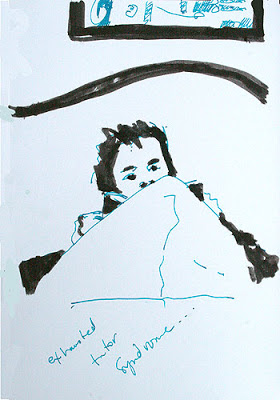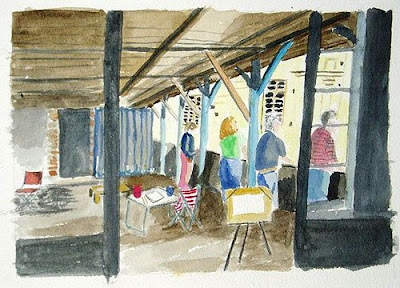Back from teaching two workshops. Ah me, blogging again? When I get out of bed… maybe…. & clear the decks in the office, family & garden. La Reprise.
A5 sketchbook
© the artist
Hope this post doesn’t sound too spammy self-promotional nor too much like me banging away.
Painters & Draughts-Persons
It’s also good fun to paint people painting & drawing. All levels of painters should try it, IMO. Here’s a watercolour that a student did in the studio during one of the Painting Holidays in France that I’ve lead over the years.
Chris Sharland
© the artist
Demonstration Piece – one hour 15 mins
Watercolour.
28 x 38cm (15 x 11 inches).
© The Artist.

DETAIL : ‘Painters in the Park’
Demonstration Piece – one hour 15 mins
Watercolour.
28 x 38cm (15 x 11 inches).
© The Artist.
I was quite pleased with the above two figures. The watercolour is fresh & ‘just-so’, if I may say so, somewhat immodestly.
Lots of quick scribbles too. Of people moving about, painting & drawing. ‘Moving targets’. These sketches were done in less than five minutes each ‘take’.
‘Picnic People’
A5 Sketchbook
© The Artist.
‘Pat’
A5 sketchbook
© The Artist.

‘The Chairman’
A5 sketchbook
© the artist
©the artist
The above are demonstration pieces. Should one exhibit them? Learning is the desired product & not a finished painting.
The Educative Value of Demonstrations
I believe in the value of demos. True that they are only one teaching technique amongst many others. Sometimes the learning environment can get too wordy, so watching someone paint, seeing a painting unfold before your eyes can open up the non-verbal & encourage the natural.

WORK IN PROGRESS – unfinished state – two hours demonstration piece
‘A. & I. Painting’
Full Sheet Watercolour
56 x 76 cm (30″ x 22″)
© adam cope
Now please don’t get me wrong, I do know that the real goal is student-centered learning & not tutor showing-off. However, by seeing an experienced painter in action, who is also teaching & explaining – ‘sur la vif’ & in front of the subject – is something you won’t find neither on internet nor in a book. I myself have learnt so much this way ( & would be game to do so again).
Demos also quickly sort the chaff from the grain; if a teacher doesn’t have the years of painting experience integrated into his or her hands, his or her gestures, well then …. you should ask yourself just who do you have as tutor?
Here is some of what I have to say about the good uses of demonstration as a teaching/learning technique. I quote from my website What Makes a Good Painting Workshop Tutor? (hoping that this won’t trip a google duplicate content filter…nor sound too self-important nor spammy)
“A true teacher does not explain – he invites you to stand beside him and see for yourself.” Raymond Inmon
“A picture is worth a thousand words and watching a picture being painted is worth even more….The best teachers I’ve had show you rather than tell you how to do something. Talking the talk is far less important than walking the walk.” – Charles Sovek










